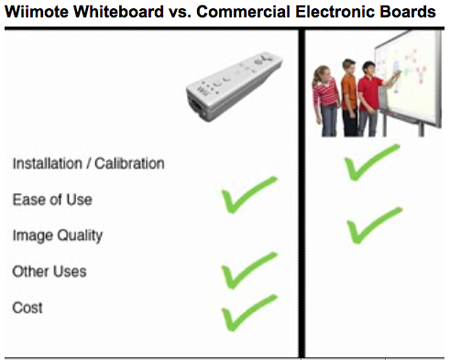Drew McKinney—who I hope winds up in Bloomington next year in the HCI/d program at Indiana University—just released his video comparing Johnny Lee’s Wiimote Whiteboard hack with commercial smart boards, like the one used in his mom’s middle school classroom.
Drew McKinney compares a Wiimote Whiteboard with a commercial option
Drew noted that there are two main weaknesses with commercial options: reliance on dedicated hardware, and the poor quality of their touch sensitivity. The markers have identity embedded in them, which means selection of colors requires the system knowing that the blue marker, for example, is back in its cradle. It is also common to have hand movements misinterpreted as marks, which can lead to a frustrating experience for users.
The wiimote whiteboard isn’t a perfect option, either. The quality of the lines are jagged, although Lee attributes that primarily to placement of the wiimote. McKinney suggests using a microphone stand instead of a table mount to help facilitate fine-tuned placement and lessen the chance of disturbances, like jostling the device when accidentally kicking the table. However, the versatility it provides by allowing the interaction to occur on any surface, like walls and tables, and scale to practically any size makes it significantly more adaptable to individual needs. Since the pen serves as a mouse, the functionality can be more than just marking a wall. It may be a nice way to demonstrate applications and play games in front of a group.
The biggest difference, of course, is the cost. It cost about $50 to create Lee’s wiimote version, whereas vendors charge upwards of $3000 for smart boards.

11 replies on “Wiimote Whiteboard compared to vendor option”
Drew Mickinney posted a YouTube video evaluating the Wiimote whiteboard against a commercial whiteboard in a middle school setting and found that there are many advantages to the Wiimote whiteboard. Kevin Makice also hasa writeupof the video. We’re not the only ones who are doing this project. An Amazon page for IR LEDs showed that other people were buy the same parts to create this project. Other schools have also built Wiimote whiteboards:
[…] The wiimote whiteboard is a program developed Johnny Chung Lee.Here’s his wiimote project directory.Here’s a report detailing the differences between a SMART Board and a Wiimote Whiteboard.He also has some other interesting programs for use with the wiimote, so it might be worth looking […]
[…] Think again. Still not convinced this really does work? Check out a great written explanationhere. I personally know of three teachers already who have this running, and they say it’s […]
[…] interest I would hope an opensource version would appear. http://www.ted.com/talks/view/id/245 http://www.blogschmog.net/2008/01/13/wiimote-whiteboard-compared-to… Has anyone explored this? Would […]
[…] TED | Talks | Johnny Lee: Creating tech marvels out of a $40 Wii Remote (video) about 4 hours agoWiimote Whiteboard compared to vendor option | BlogSchmog about 4 hours agoLesson Activity Toolkit – SMART Exchange on 2008-04-17Many Uses for ‘New York […]
[…] Links zum Thema: http://www.blogschmog.net/2008/01/13/wiimote-whiteboard-compared-to-vendor-option/ [bearbeiten] Schüler Mathias Feizinger (feitzi@gmail.com) Kristina Grekulovic […]
[…] Wiimote Whiteboard compared to vendor option Number of comments: 1Drew McKinney—who I hope winds up in Bloomington next year in the HCI/d program at Indiana University—just released his video comparing Johnny Lee’s Wiimote Whiteboard hack with commercial smart boards, like the one used in his mom’s middle school classroom. […]
[…] Wiimote whiteboard vs. commercial options […]
I want share with you a veru powerfull software to be used with the wiimote whiteboard
http://code.google.com/p/ardesia/
Ardesia enables you to make colored free-hand annotations on your computer screen, record it and share on the network.
This is especially useful when making presentations, to highlight things or point out things of interest.
The tool facilitates the online presentations and demos showing in real time your computer screen to anyone in the network.
Ardesia is XInput-Aware, so if you have a mouse, a graphic tablet, a touch screen, a wiimote whiteboard or a commercial whiteboard; you can draw lines with different strength, select color, erase things and draw arrows.
You can free-hand draw geometrical shapes using the shape recognizer, insert text with the keyboard and highlight screen areas. You can draw upon the desktop or select an image as background.
[…] Wiimote Whiteboard compared to vendor option | BlogSchmog SAVE […]
WiildOs 1.3.2 is out,
WiildOs is an educational live and installable GNU/Linux distro build
from the Ardesia stuff and thinking for teaching purposes. It includes
the software that enable you to use a wiimote whiteboard.
WiildOs includes lubuntu-desktop, python-whiteboard, ardesia, sankore,
spotlighter, curtain, florence-ramble, wmgui, wiican, easystroke,
whyteboard, vmg, shutter, gimp, tuxpaint, tuxmath, tuxtype, dia,
scribus, audacity, stellarium, xournal, gcompris, geogebra, wxmaxima,
openoffice.org, jokosher, musescore, solfege, stellarium, dasher,
eviacam and more!
More info on http://code.google.com/p/ardesia/wiki/WiildOs
Build a wiildOs4win wubi like installer that allow to install wiildOs
inside windows without partitioning the hard disk.
http://ardesia.googlecode.com/svn/wiki/wiildOs/wiildOs4win.exe
Changelog
– new kernel 2.6.35; this add the support to some new devices including
the toshiba bluettoth
– thunderbird in now the default mailer instead of sylpheed
– firefox is the default browser instead of chromium
– removed xscreensaver for performance issue
– remove all the gnome office suite; we use openoffice suite
– fix the wiican program; now you can you use the wiimote as controller
usinf the infrared camera or the accelerometers in a visual user
friendly way